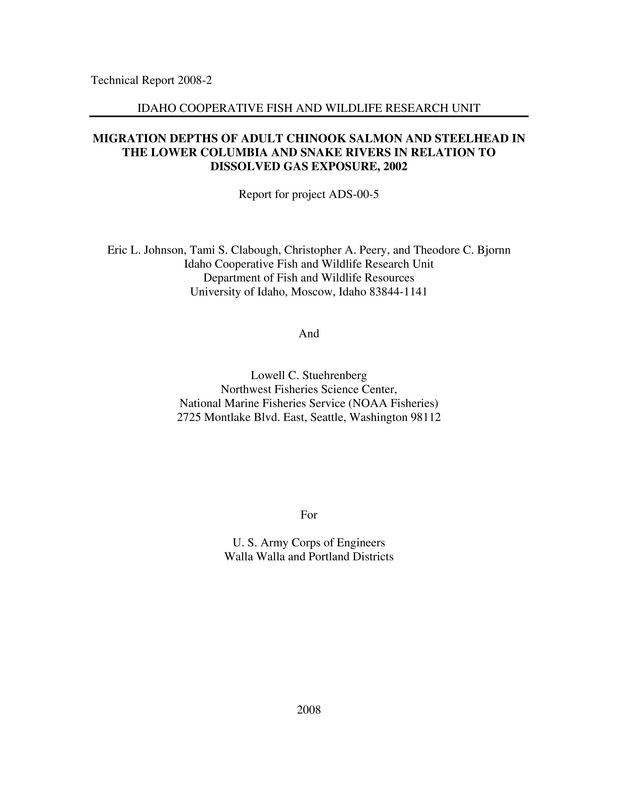PDF
Migration Depths Of Adult Chinook Salmon And Steelhead In The Lower Columbia And Snake Rivers In Relation To Dissolved Gas Exposure, 2002 Item Info
- Title:
- Migration Depths Of Adult Chinook Salmon And Steelhead In The Lower Columbia And Snake Rivers In Relation To Dissolved Gas Exposure, 2002
- Report Type:
- Technical Report
- Date:
- 2008
- Authors:
- Johnson, E.L.; Clabough, T.S.; Peery, C.A.; Bjornn, T.C.; Stuehrenberg, L.C.
- Affiliations:
- Fish and Wildlife Sciences, University of Idaho; National Marine Fisheries Service, National Oceanic and Atmospheric Administration
- Report Number:
- 2008-2
- Publisher:
- University of Idaho
- Funder:
- U.S. Army Corps of Engineers, Portland District; U.S. Army Corps of Engineers, Walla Walla District
- Abstract:
- High spill volume at dams can create supersaturated dissolved gas conditions that may have negative effects on fishes. During 2002, 184 adult Chinook salmon Oncorhynchus tshawytscha and 231 steelhead Oncorhynchus mykiss were tagged at Bonneville Dam with archival radio-data storage transmitters (RDSTs) that recorded depth and water temperature as they migrated through dams and reservoirs of the lower Columbia and Snake rivers. These data were used to estimate the degree of exposure to gas supersaturated conditions. Migration depth plays a role in the development of gas bubble disease because hydrostatic compensation reduces the effects of exposure to supersaturation at greater depths. We found that adult spring and summer Chinook salmon and steelhead spent a majority of their time at depths deeper than 2 m (providing at least 20% hydrostatic compensation). However, migration depths below 2 m were interspersed with periods lasting several minutes at depths shallower than 2 m. Statistical associations were weak between dissolved gas concentrations and the percent and duration of time fish occupied near-surface waters. Based on the observed migration depths and dissolved gas conditions in the river, biological effects resulting from depth uncompensated exposure to dissolved gas were likely minimal in 2002.
- Species:
- Steelhead, Oncorhynchus mykiss Chinook salmon, Oncorhynchus tshawytscha
- Location:
- Bonneville Dam; Columbia River; Snake River; Lower Granite Dam; Dodson Oregon; Skamania Washington
- Subjects:
- salmonids Federal Columbia River Power System FCPRS radiotelemetry dissolved gas concentrations migration depth fish physiology gas bubble disease
- Source:
- University of Idaho, Fish Ecology Research Lab
- Original Filename:
- 2008-02-CK-SH-depths-in-relation-to-dissolved-gas-lower-Columbia-River-2002.pdf
- Format:
- application/pdf
Source
- Preferred Citation:
- "Migration Depths Of Adult Chinook Salmon And Steelhead In The Lower Columbia And Snake Rivers In Relation To Dissolved Gas Exposure, 2002", Adult Salmon and Steelhead Migration Studies: 1996-2014, University of Idaho Library Digital Collections, https://www.lib.uidaho.edu/digital/ferl/items/ferl-tr-2008-2.html
Rights
- Rights:
- These files are provided for research purposes with copyright held by the original authors. Please contact the publishing organization for more information about rights.
- Standardized Rights:
- http://rightsstatements.org/vocab/InC-EDU/1.0/

